Knee Pain?? I bet it's your IT Band
The knee is the tough, crotchety old bugger of the body. It can take a serious beating, as evidence by long distance runners and their 50-100,000 foot strikes in a race, as well as pretty much any NFL running back, basketball player, or tennis player out there. Also evident of their crotchetiness is every distance runner, NFL running back, basketball player and tennis player who had their careers ended from a knee injury. The knee is incredibly important, incredibly simple (3 bones, a few ligaments and muscles, and 2 degrees of freedom), and incredibly dumb, as it takes up the slack of the work that the hip and ankle don’t want to do. I mean really, if one boss was an asshole, and the other kept on walking all over ou, you would probably give up and take the next train outta there too, right??
The IT band is a seriously important piece of tissue that doesn’t tend to get the respect it deserves from the training community. Essentially the majority of trainers out there would say to simply “roll it out” and then go right back to training the way it’s always been trained: leg press with a medicine ball between the knees, partial squats, cross-over stretches, and other crap-tacular methods of leg work that will do nothing but inflame the IT band when it comes time to work again. This either shows a lack of understanding of the anatomy and function of the IT band, a lack of understanding of the role of the exercises being used in IT band stress, or both. TOday, gentle reader, I’m going to school you on some fantastic IT band necessities for your training tool box.
Let’s start at the beginning with anatomy. Check out the pretty picture below to get an idea of what the IT Band is.
It runs from the hip to the outside of the shin just below the knee joint (from the illiac crest to the tibia, hence illio-tibial band), and is primarily composed of type 3 collagen fibres, which are really stiff and resilient. It’s the same type of collagen found in the intervertebral discs of the spine, so you know what kind of forces it can handle.The tensor fascia latea (TFL) is considered to be the main hip muscle that the IT band connects to, but looking at the diagram, the fascial connections seem to also connect heavily through the glute maximus as well as the deep glute medius underneath. On the bottom, it ties in nicely with the tibialis anterior and through the proximal fibres of the peroneus muscles, so it has a pretty important role in total leg stability against lateral deviations. I’ve talked about the role of fascial connectivity and the role of muscle force and tension in Muscle Imbalances Revealed, so I’ll skip over some of the anatomical components that are really juicy and scientifically geek-tastic to keep everyone else from trying to gouge their eyes out from the sheer awesomeness of it all. But if you’re so inclined, you can get your copy of Muscle Imbalances Revealed HERE.
Now let’s say we’re taking the knee through a flexion and extension range of motion. The IT band glides along the femoral condyles as the knee bends and straightens, as shown here.
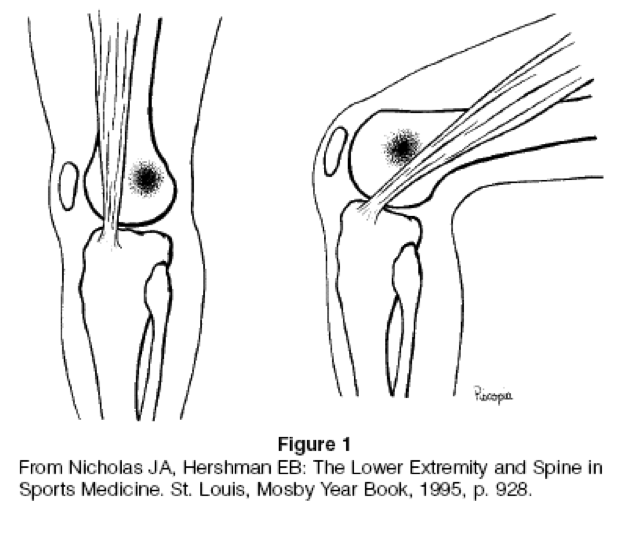 The problem with IT band friction is that as the IT band slides along this condyle, it create a small amount of friction that can begin to wear away at the underside of the IT band, sort of like a fraying rope. In some people, these condyles are more prominent and ragged, and will wear away the back side more than in others, but these people tend to be older with some osteoarthritic changes to the knees. As a result of the friction and fraying, the body starts laying down scar tissue in the form of loose collagen and adhesive chemical compounds (commonly called “adhesions” in some manual therapy circles) so that the tissue can handle the stress being applied. This collagen scar tissue is loaded with nerve tissue, and tugging on it creates pain, which is present when the knee is bent under load, lifted against gravity, or if the hamstring is contracted against gravity. Passive movement doesn’t hurt whatsoever, as the IT band isn’t being pulled taut against the femoral condyle. The pain from the IT band friction looks like this, with the X’s representing point tenderness, and the reddish area representing dull aching and a deeper type of pain.
The problem with IT band friction is that as the IT band slides along this condyle, it create a small amount of friction that can begin to wear away at the underside of the IT band, sort of like a fraying rope. In some people, these condyles are more prominent and ragged, and will wear away the back side more than in others, but these people tend to be older with some osteoarthritic changes to the knees. As a result of the friction and fraying, the body starts laying down scar tissue in the form of loose collagen and adhesive chemical compounds (commonly called “adhesions” in some manual therapy circles) so that the tissue can handle the stress being applied. This collagen scar tissue is loaded with nerve tissue, and tugging on it creates pain, which is present when the knee is bent under load, lifted against gravity, or if the hamstring is contracted against gravity. Passive movement doesn’t hurt whatsoever, as the IT band isn’t being pulled taut against the femoral condyle. The pain from the IT band friction looks like this, with the X’s representing point tenderness, and the reddish area representing dull aching and a deeper type of pain.
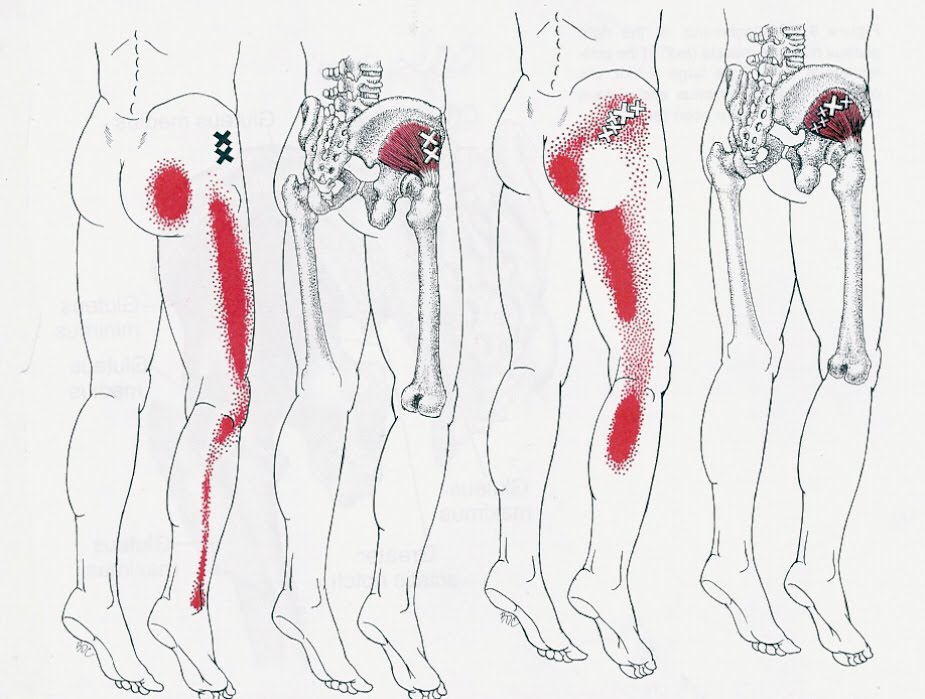 Most people will complain of pain across and curling under the lateral aspect of the knee cap, and will exhibit a gethtehellawayfromme reaction if you dig a knuckle into their IT band, which is a common test I use to determine if the IT band is tight or not. This is simply because it’s fun and a little mean, but also gives people an idea of how messed up their IT band may be.
Most people will complain of pain across and curling under the lateral aspect of the knee cap, and will exhibit a gethtehellawayfromme reaction if you dig a knuckle into their IT band, which is a common test I use to determine if the IT band is tight or not. This is simply because it’s fun and a little mean, but also gives people an idea of how messed up their IT band may be.
What you can’t see here is that when I do the second pass with the middle knuckle along her IT band, she not only shifted away from me slightly, but had a scrunched up face so tight trying to block out the pain that I thought she would actually implode and get stuck like that forever!!
If the IT band gets tight, it can really torque on the knee joint, and can make a happy little hinge joint rotate off its’ axis, resulting in excessive wear and tear of the internal structure, and premature aging of the joint surfaces.
On top of that, the IT band plays a direct role in lumbar function, as it ties into the glutes and sacroillic and thoracolumbar fascia through a loop even Thomas Meyers didn’t think of. The yellow line is my little addition to the puzzle.
Because of its’ role in stability and mobility, the IT band is a pretty big deal. Since it’s so tied into a lot of different troublesome areas of the body, it could be easy to jump to the conclusion that dysfunctional IT bands lead into dysfunctional low back/hip/knee/foot/hymen, but it would be pretty irresponsible of me to do that. Sure, the IT band may be involved, but odds are it doesn’t cause the problems, but is rather a secondary symptom of an deeper cause of some form of muscle imbalance. However, in most cases, properly releasing the IT band adhesions can reduce the overall pain felt in all these areas, which will allow you to address the deeper issues more effectively, so you be the judge.
A lot of the time, the fibres of the scar tissue that are adhesing the IT band will also bind into the vastus lateralis of the quad muscle for support, which will make contracting the quad that much more difficult and painful for the person. There’s a lot of options to reduce the adhesions, things like Graston technique:
…active release, or self myofascial release with a foam roller:
One thing I’ve found that works extremely well with IT band rolling is to turn the body slightly towards the ground in order to contact the VLO, as shown in the clip when I go from lying on the side to turning face towards the mats. As well, when the tender spots are found (trust me, you’ll know when you hit them), flexing the knees can help to stretch the muscle fibres under compression, which will help to break up the adhesions even better.
With the adhesions reduced, the best way to strengthen the body to reduce the chances of having a recurrence is to train the glute maximus and medius to effectively “reposition” the tension of the IT band. Couple this with increasing balance and forcing the foot to allign better with the ankle to reduce stress through the peroneals and tibialis anterior, and you’ve got yourself a happy little ball of fascial awesome just waiting to creep on out there and say howdy to the world!!
Once you’ve broken down the adhesions with some quality foam rolling, and hopefully some graston or active release, you’ll need to stretch the quads to make sure any remaining adhesions aren’t binding to the muscle belly and restricting movement.
To increase glute strength for IT band pain, the glute hip press and one foot squat & row seem to produce the best results.
Retraining the quads to fire with the glutes will also become important, as the adhesive fibres on the IT band will bind the quads and make them less than stable. Give these little beauties a try.
For those looking for a funny funny today, hey I gotta flex my brain muscles once in a while. Plus, smart guys kick ass.
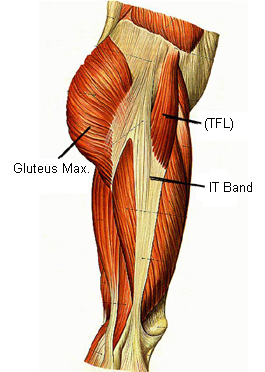
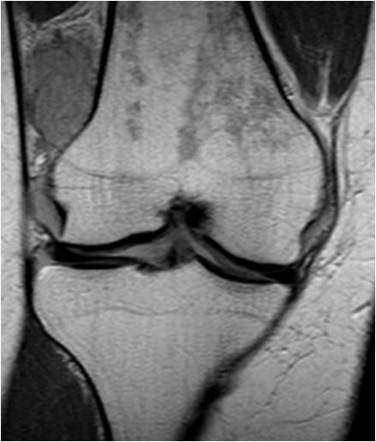
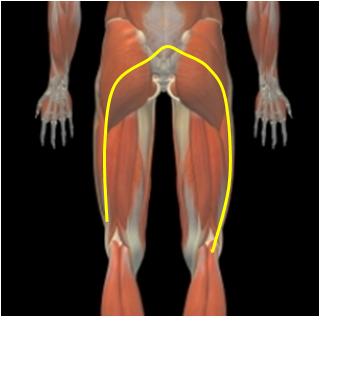

31 Responses to Knee Pain?? I bet it's your IT Band